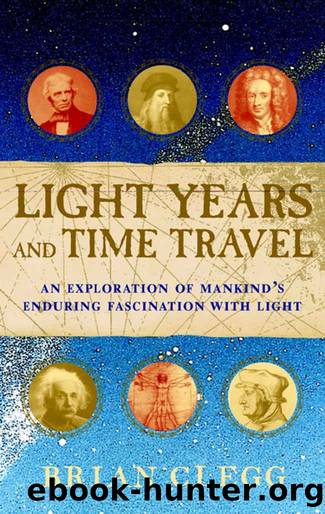Light Years and Time Travel by Brian Clegg

Author:Brian Clegg [Clegg, Brian]
Language: eng
Format: azw3, epub
ISBN: 9780471262060
Publisher: Turner Publishing Company
Published: 2007-08-02T16:00:00+00:00
A LONG ENOUGH MEASURE
Ironically, it was a success of Galileoâs that made Roemerâs measurement possible. It was a measurement that Roemer never intended to make. He was working at the University of Paris, timing the four largest moons of Jupiter as they moved in and out of the giant planetâs shadow. His hope was to provide navigators with a natural clock to pinpoint time while they were at sea.
Year by year, ships had been dashed on the rocks and destroyed, led astray by imprecise measurements. Calculating the position of a vessel depended on accurate timekeeping, impossible onboard ship with the crude mechanical clocks of the day. Ever since Galileoâs discovery of Jupiterâs moons in 1610, astronomers had been trying to map the regular movements of these distant points of light to use them as a precision timepiece. But Roemer discovered that the moons did not behave as he expected. The timings did not stay constant, but grew later by the day. Roemer was curious. Why did the moons seem to be slowing down?
It was only the fact that his measurements were taken over a long period that gave Roemer the chance to realize what was happening. Day by day, the timings shifted, until one day the change was reversed. Now the timings became earlier every day. Roemer noticed that the change coincided with the time when Earth was at its most distant point from Jupiter. It was too big a coincidence to be unconnected. Roemer knew that as the Earth and Jupiter described sweeping arcs through the solar system, the distance between the planets grew bigger, reached a maximum, then grew smaller again. While the distance to Jupiter was increasing, the light took longer to reach him each day because it had further to travel. This extra time taken for the light to arrive made the appearances and disappearances of the moons seem later than they really were. Roemer only had to compare the change in timing with the change in distance to work out lightâs speed.
With the help of fellow-astronomer Cassiniâs measurements of Jupiterâs distance from the sun, Roemer came up with a figure for the speed of light. At 220,000 kilometres a second he was almost a third too low, but the inevitable progress towards an accurate figure had begun.
While Roemerâs measurements were improved on, there was something not quite satisfying about using the remote movement of heavenly bodies to pin down lightâs speed. It would only seem truly in humanityâs grasp if the measurement could be brought down to Earth. The man to do it was French, Armand Hippolyte Louis Fizeau. His idea was in many ways similar to Galileoâs â it involved measuring the time for a beam of light to make a round trip to a distant point and back again. But how was he to get over Galileoâs problem of timing a journey that would only take a fraction of a second? It was 1849, a very different era from Galileoâs. Rather than rely on human reactions, Fizeau, a product of the mechanical age, opted for a mechanical solution.
Download
This site does not store any files on its server. We only index and link to content provided by other sites. Please contact the content providers to delete copyright contents if any and email us, we'll remove relevant links or contents immediately.
The Complete Stick Figure Physics Tutorials by Allen Sarah(7334)
Secrets of Antigravity Propulsion: Tesla, UFOs, and Classified Aerospace Technology by Ph.D. Paul A. Laviolette(5330)
Thing Explainer by Randall Munroe(3904)
The River of Consciousness by Oliver Sacks(3569)
The Order of Time by Carlo Rovelli(3161)
How To by Randall Munroe(3074)
A Brief History of Time by Stephen Hawking(2990)
I Live in the Future & Here's How It Works by Nick Bilton(2957)
What If?: Serious Scientific Answers to Absurd Hypothetical Questions by Randall Munroe(2667)
The Great Unknown by Marcus du Sautoy(2661)
Midnight in Chernobyl by Adam Higginbotham(2514)
Blockchain: Ultimate Step By Step Guide To Understanding Blockchain Technology, Bitcoin Creation, and the future of Money (Novice to Expert) by Keizer Söze(2465)
Networks: An Introduction by Newman Mark(2382)
The Meaning of it All by Richard Feynman(2317)
Easy Electronics by Charles Platt(2304)
The Tao of Physics by Fritjof Capra(2247)
Midnight in Chernobyl: The Untold Story of the World's Greatest Nuclear Disaster by Adam Higginbotham(2195)
Introducing Relativity by Bruce Bassett(2097)
When by Daniel H Pink(2097)
